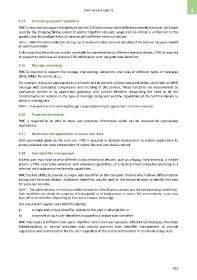Page 433 - 5G Basics - Core Network Aspects
P. 433
Core network aspects 1
9.14 Accounting support capabilities
FMC is required to support the ability to collect CDR information from different network elements, which are
used by the charging/billing system to gather together relevant usage data to initiate a unified bill to the
specific user for multiple kinds of services with different terminal devices.
NOTE – CDR information collection among one or several providers can only take place if the end user has given implicit
or explicit permission.
In the case that the end user may be reachable by one identifier on different terminal devices, FMC is required
to support to associate all relevant CDR information with the particular identifier.
9.15 Message processing
FMC is required to support the storage, transcoding, conversion and relay of different types of messages
(SMS, MMS, IM, email, etc.).
For example, it may be appropriate to transcode and to convert a video contained within an IM into an MMS
message with associated compression and recoding of the content. These functions are implemented by
application servers or by application gateways with control elements recognizing the need to do the
transformation in relation to the type of message being sent and the capabilities of the terminal device to
which it is being sent.
NOTE – Transport-level interworking through encapsulation may be appropriate in certain scenarios.
9.16 Presence information
FMC is required to be able to store user presence information which can be accessed by appropriate
applications.
9.17 Mechanism for applications to access user data
With permission given by the end user, FMC is required to provide mechanisms to enable applications to
access relevant user data independent of where the end user data is stored.
9.18 User identifier management
An end user may have several different kinds of terminal devices, such as a legacy fixed terminal, a mobile
phone, a PDA, a portable computer with extended capabilities, or a desktop fixed computer operating as a
terminal with substantial multimedia capabilities.
FMC has the ability to provide a unique user identifier at the transport stratum which allows differentiation
among user terminal devices. Additional identifiers may be used at the service stratum to identify the user
for end-user services.
NOTE – The Administration or service providers choose the identification scheme and the corresponding identifier(s).
Such identifiers can exhibit the property of being public or of being private. In some FMC environments, a user may
have different identifiers depending on the access network technology.
It is required to support user identification by:
a) a single and unique identifier related to the user's subscription; or
b) a number of such user identifiers mapped to a unique user identifier.
FMC may apply a different end users' identifier when end user accesses different technologies, therefore
Administrations or service providers may require common user identifier management to provide
registration and authorization for the user regardless of the access mechanisms or terminals being used.
423

